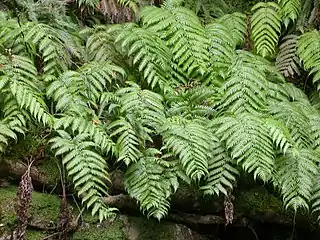| Woodwardia Temporal range: | |
|---|---|
 | |
| Woodwardia radicans | |
| Scientific classification | |
| Kingdom: | Plantae |
| Clade: | Tracheophytes |
| Division: | Polypodiophyta |
| Class: | Polypodiopsida |
| Order: | Polypodiales |
| Suborder: | Aspleniineae |
| Family: | Blechnaceae |
| Subfamily: | Woodwardiodeae |
| Genus: | Woodwardia Sm. |
| Species | |
|
See text. | |
| Synonyms | |
| |
Woodwardia is a genus of ferns in the family Blechnaceae, in the suborder Aspleniineae (eupolypods II) of the order Polypodiales.[1][2] Species are known as netted-chain ferns. The genus is native to warm temperate and subtropical regions of the Northern Hemisphere. They are large ferns, with fronds growing to 50–300 cm long depending on the species. The fossil record of the genus extends to the Paleocene.[3]
Taxonomy
Woodwardia was first described by James Edward Smith in 1793.[4] It was named after Thomas Jenkinson Woodward.[5] When broadly circumscribed, the genus contains about 15 species (plus some hybrids). In the Pteridophyte Phylogeny Group classification of 2016 (PPG I), the genera Anchistea and Lorinseria (each with one species) are kept separate.[1]
Species
As of August 2019, Plants of the World Online accepts the following species,[6] excluding those placed in other genera in the PPG I system.[1]
- Woodwardia auriculata Blume
- Woodwardia fimbriata Sm.
- Woodwardia harlandii Hook.
- Woodwardia intermedia Christ
- Woodwardia japonica (L.f.) Sm.
- Woodwardia kempii Copel.
- Woodwardia magnifica Ching & P.S.Chiu
- Woodwardia martinezii Maxon ex Weath.
- Woodwardia orientalis (Sw.) Sw.
- Woodwardia prolifera Hook. & Arn.
- Woodwardia radicans (L.) Sm.
- Woodwardia spinulosa M.Martens & Galeotti
- Woodwardia unigemmata (Makino) Nakai
Species placed elsewhere in PPG I are:[1]
- Woodwardia areolata (L.) T.Moore = Lorinseria areolata (L.) C.Presl
- Woodwardia virginica (L.) Sm. = Anchistea virginica (L.) C.Presl
 Some species have large leaves, such as W. orientalis. Leaves are deeply bipinnatifid. Young leaves of W. orientalis are red and the young adventitious buds on the leaf surface are also red.
Some species have large leaves, such as W. orientalis. Leaves are deeply bipinnatifid. Young leaves of W. orientalis are red and the young adventitious buds on the leaf surface are also red.
References
- 1 2 3 4 PPG I (2016). "A community-derived classification for extant lycophytes and ferns". Journal of Systematics and Evolution. 54 (6): 563–603. doi:10.1111/jse.12229. S2CID 39980610.
- ↑ Maarten J. M. Christenhusz; Xian-Chun Zhang & Harald Schneider (2011). "A linear sequence of extant families and genera of lycophytes and ferns" (PDF). Phytotaxa. 19: 7–54. doi:10.11646/phytotaxa.19.1.2.
- ↑ Song, Han-Zhang; Naugolnykh, Serge V.; Wu, Xin-Kai; Liu, Xiao-Yan; Jin, Jian-Hua (September 2021). "Fertile Woodwardia from the middle Eocene of South China and its implications for palaeogeography and palaeoclimate". Plant Diversity. 44 (6): 565–576. doi:10.1016/j.pld.2021.09.003. PMC 9751083. PMID 36540713. S2CID 240534497.
- ↑ "Woodwardia Sm". The International Plant Names Index. Retrieved 2019-08-09.
- ↑ McConnell, Anita. "Woodward, Thomas Jenkinson". Oxford Dictionary of National Biography (online ed.). Oxford University Press. doi:10.1093/ref:odnb/26073. (Subscription or UK public library membership required.)
- ↑ "Woodwardia Sm". Plants of the World Online. Royal Botanic Gardens, Kew. Retrieved 2019-08-09.
External links
- Germplasm Resources Information Network: Woodwardia
- Flora of North America: Woodwardia
- Flora of China: Woodwardia species list
- Smith's original description of the genus online at Project Gutenberg
- Huxley, A., ed. (1992). New RHS Dictionary of Gardening. Macmillan.